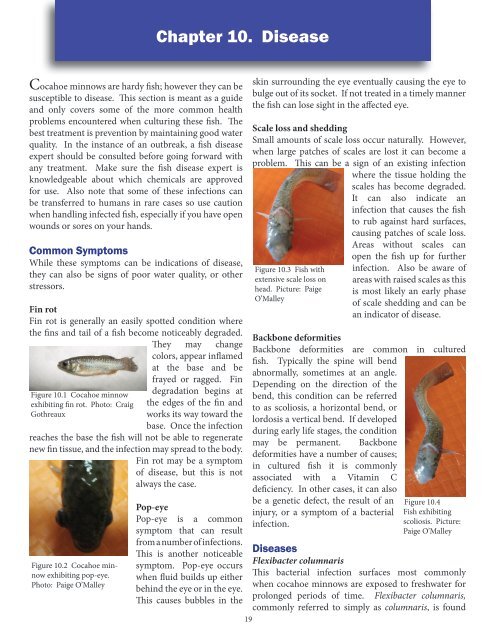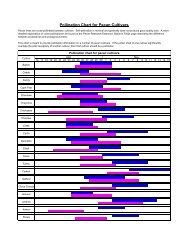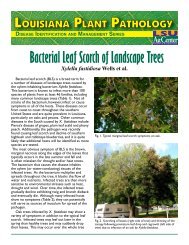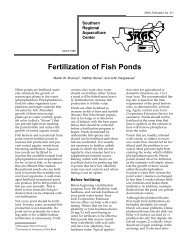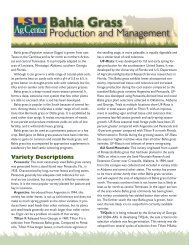Cocahoe Minnow - The LSU AgCenter
Cocahoe Minnow - The LSU AgCenter
Cocahoe Minnow - The LSU AgCenter
You also want an ePaper? Increase the reach of your titles
YUMPU automatically turns print PDFs into web optimized ePapers that Google loves.
Chapter 10. Disease<br />
<strong>Cocahoe</strong> minnows are hardy fish; however they can be<br />
susceptible to disease. This section is meant as a guide<br />
and only covers some of the more common health<br />
problems encountered when culturing these fish. <strong>The</strong><br />
best treatment is prevention by maintaining good water<br />
quality. In the instance of an outbreak, a fish disease<br />
expert should be consulted before going forward with<br />
any treatment. Make sure the fish disease expert is<br />
knowledgeable about which chemicals are approved<br />
for use. Also note that some of these infections can<br />
be transferred to humans in rare cases so use caution<br />
when handling infected fish, especially if you have open<br />
wounds or sores on your hands.<br />
Common Symptoms<br />
While these symptoms can be indications of disease,<br />
they can also be signs of poor water quality, or other<br />
stressors.<br />
Fin rot<br />
Fin rot is generally an easily spotted condition where<br />
the fins and tail of a fish become noticeably degraded.<br />
<strong>The</strong>y may change<br />
colors, appear inflamed<br />
at the base and be<br />
frayed or ragged. Fin<br />
skin surrounding the eye eventually causing the eye to<br />
bulge out of its socket. If not treated in a timely manner<br />
the fish can lose sight in the affected eye.<br />
Scale loss and shedding<br />
Small amounts of scale loss occur naturally. However,<br />
when large patches of scales are lost it can become a<br />
problem. This can be a sign of an existing infection<br />
where the tissue holding the<br />
scales has become degraded.<br />
It can also indicate an<br />
infection that causes the fish<br />
to rub against hard surfaces,<br />
causing patches of scale loss.<br />
Areas without scales can<br />
open the fish up for further<br />
Figure 10.3 Fish with<br />
extensive scale loss on<br />
head. Picture: Paige<br />
O’Malley<br />
infection. Also be aware of<br />
areas with raised scales as this<br />
is most likely an early phase<br />
of scale shedding and can be<br />
an indicator of disease.<br />
Backbone deformities<br />
Backbone deformities are common in cultured<br />
fish. Typically the spine will bend<br />
abnormally, sometimes at an angle.<br />
Depending on the direction of the<br />
Figure 10.1 <strong>Cocahoe</strong> minnow degradation begins at<br />
bend, this condition can be referred<br />
exhibiting fin rot. Photo: Craig the edges of the fin and<br />
to as scoliosis, a horizontal bend, or<br />
Gothreaux<br />
works its way toward the<br />
lordosis a vertical bend. If developed<br />
base. Once the infection<br />
during early life stages, the condition<br />
reaches the base the fish will not be able to regenerate<br />
may be permanent. Backbone<br />
new fin tissue, and the infection may spread to the body.<br />
deformities have a number of causes;<br />
Fin rot may be a symptom<br />
in cultured fish it is commonly<br />
of disease, but this is not<br />
associated with a Vitamin C<br />
always the case.<br />
deficiency. In other cases, it can also<br />
Pop-eye<br />
Pop-eye is a common<br />
symptom that can result<br />
be a genetic defect, the result of an<br />
injury, or a symptom of a bacterial<br />
infection.<br />
Figure 10.4<br />
Fish exhibiting<br />
scoliosis. Picture:<br />
Paige O’Malley<br />
Figure 10.2 <strong>Cocahoe</strong> minnow<br />
exhibiting pop-eye.<br />
Photo: Paige O’Malley<br />
from a number of infections.<br />
This is another noticeable<br />
symptom. Pop-eye occurs<br />
when fluid builds up either<br />
behind the eye or in the eye.<br />
This causes bubbles in the<br />
19<br />
Diseases<br />
Flexibacter columnaris<br />
This bacterial infection surfaces most commonly<br />
when cocahoe minnows are exposed to freshwater for<br />
prolonged periods of time. Flexibacter columnaris,<br />
commonly referred to simply as columnaris, is found


